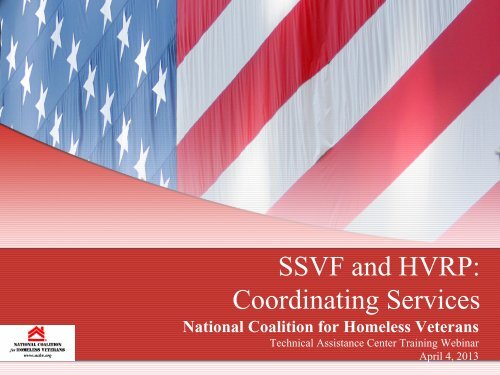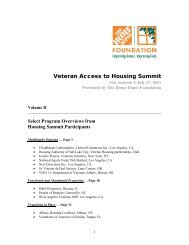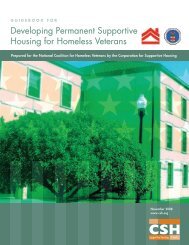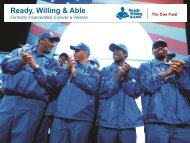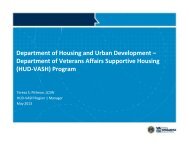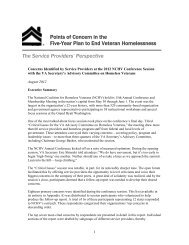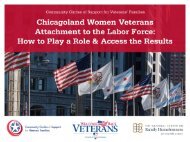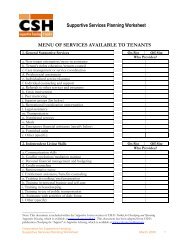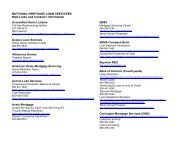SSVF and HVRP - National Coalition for Homeless Veterans
SSVF and HVRP - National Coalition for Homeless Veterans
SSVF and HVRP - National Coalition for Homeless Veterans
- No tags were found...
Create successful ePaper yourself
Turn your PDF publications into a flip-book with our unique Google optimized e-Paper software.
Logistics• April 4, 2013 3:00 p.m. EDT – 4:00 p.m. EDT• Log-in instructions (sent in reminder today)• 1. To join by webinar: Within 10 minutes of the training's start time, log in here:http://lotuslive.readyshow.com using the following participant code: 26432122. You will beable to hear the audio of the call through your computer, or you can listen to the audio overthe phone by dialing 1-877-366-0711 <strong>and</strong> providing the operator with the followingparticipant code: 26432122• 2. To join by phone only (not using webinar plat<strong>for</strong>m): Please dial 1-877-366-0711 within 10minutes of the training's start time <strong>and</strong> provide the operator with the following participantcode: 26432122. The presentation PDF is available here:http://nchv.org/index.php/service/service/teleconference/• Asking questions• Email bcrone@nchv.org• Type questions into “chat box” on right h<strong>and</strong> side of screen• Insert questions into post-webinar survey• Next steps• Complete post-webinar survey• Check back at www.nchv.org <strong>for</strong> follow-up materials
Agenda• Webinar Objectives• <strong>HVRP</strong> Overview: Goals, Objectives, <strong>and</strong> Introduction to a New SGA• <strong>SSVF</strong> Overview: Building Programs from Experiences in the Field• Grantee Perspective:• Coordinated case management <strong>and</strong> enrollment• Housing placement <strong>and</strong> housing stability• Removing Legal barriers to employment• Q&A
<strong>HVRP</strong> Overview:Goals <strong>and</strong> Objectives• Goals:• To provide services to assist in reintegrating homeless veterans intomeaningful employment within the labor <strong>for</strong>ce <strong>and</strong>;• To stimulate the development of effective service delivery systems that willaddress the complex problems facing homeless veterans.• Three-pronged strategy:• Design, Develop, <strong>and</strong> Execute goals <strong>and</strong> strategies that• create positive Training, Employment <strong>and</strong> Retention outcomes
<strong>HVRP</strong> Overview:Introduction to the PY 2013 SGA• Participant eligibility:• <strong>Homeless</strong>ness:• HEARTH Act definition• Imminent risk• Veteran:• Other than dishonorable• Chronically homeless• Disabling condition AND• Continuously homeless <strong>for</strong> one year OR• Four episodes of homelessness in past three years
<strong>HVRP</strong> Overview:Introduction to the PY 2013 SGA• Snapshot of Changes relevant to <strong>SSVF</strong>:• Applicant eligibility:• State <strong>and</strong> local work<strong>for</strong>ce investment boards• Public agencies• Native American tribal governments• Native American tribal organizations• For-profit/commercial entities• Non-profit (including faith-based)• Staff-up MUST occur within 30 days• Focus on female veteran services• Use of System <strong>for</strong> Award Management (SAM), not Central Contractor Registration (CCR),<strong>for</strong> registration• Housing Strategy:• “Rapid response strategy <strong>for</strong> addressing…housing needs”• Must show spectrum of housing resources, including access to af<strong>for</strong>dable <strong>and</strong> permanentsupportive housing• Quality of linkages:• Must demonstrate connectivity to <strong>SSVF</strong>
U.S. Department of <strong>Veterans</strong> Affairs<strong>Veterans</strong> Health AdministrationSupportive Services <strong>for</strong>Veteran Families (<strong>SSVF</strong>)John Kuhn, LCSW, MPH<strong>National</strong> Director, <strong>SSVF</strong>DRAFT
U.S. Department of <strong>Veterans</strong> Affairs<strong>Veterans</strong> Health AdministrationThe <strong>SSVF</strong> ProgramDRAFT
U.S. Department of <strong>Veterans</strong> Affairs<strong>Veterans</strong> Health AdministrationApproach• The goal is Housing Stability <strong>and</strong> is not contingent ontreatment.• <strong>SSVF</strong> funding to be used under “but <strong>for</strong>” criteria• Leverage grant funds to enhance housing stability of verylow-income Veteran families occupying permanent housing• Encouraged to establish relationships with Continuum ofCare• <strong>SSVF</strong> Program not intended to provide long-term support <strong>for</strong>participants, nor will it be able to address all the financial <strong>and</strong>supportive services needs of participants that affect housingstability; partnerships <strong>and</strong> referrals are critical (e.g. HUD-VASH, HUD’s Housing Choice Voucher programs,McKinney-Vento funded supportive housing programs,TANF)DRAFT10
U.S. Department of <strong>Veterans</strong> Affairs<strong>Veterans</strong> Health Administration1. Veteran Family: defined by the Veteran, includes children & nontraditionalhouseholds. Families can continue to receive services<strong>for</strong> up to a full year if Veteran leaves due to institutionalization,death, or other causes.2. Eligibility includes any veteran with a day of active serve allowingGuard <strong>and</strong> Reserves called up <strong>for</strong> short deployments to qualify –important given the reliance on these troops.3. Very Low-Income: < 50% area median income. With targets innext funding round to include:• AMI < 30%• <strong>Veterans</strong> with dependents• OEF/OIF/OND <strong>Veterans</strong>• Rural areas (need smaller, but unmet)• Tribal areasParticipant EligibilitySummaryDRAFT11
U.S. Department of <strong>Veterans</strong> Affairs<strong>Veterans</strong> Health Administration<strong>SSVF</strong> Supportive Services(Universal)1. Active outreach both in community <strong>and</strong> with local VA.2. Case management services• Careful assessment of needs in developing plans• Providing identified services directly or through referrals• Deciding how resources are allocated to participants3. Assist participants to obtain VA benefits• Service connected benefits <strong>and</strong> NSC pension• Educational benefits <strong>and</strong> vocational services• Health care4. Obtaining mainstream entitlements <strong>and</strong> services• Legal assistance• Credit counseling & financial planning• Income assistance & health insurance• Housing counselingDRAFT
U.S. Department of <strong>Veterans</strong> Affairs<strong>Veterans</strong> Health Administration• TFA budget can beincreased to 50% (hadbeen limited to 30%).• Need to submitprogram changerequest with revisedbudget.• Limits on timedescribed in FinalRule• Appropriate to ask<strong>for</strong> co-pays. Paymentsto third party only.DRAFT13
U.S. Department of <strong>Veterans</strong> Affairs<strong>Veterans</strong> Health Administration<strong>SSVF</strong> Program OverviewSupportive Services (cont’d)Type of TemporaryFinancial AssistanceTime/Amount LimitationRental Assistance* Max. of 8 months in a 3-year period; no more than 5months in any 12-month periodUtility-Fee Payment*AssistanceSecurity Deposits orUtility Deposits*Moving Costs*Emergency Supplies*Child Care**Transportation**Max. of 4 months in a 3-year period; no more than 2months in any 12-month periodMax. of 1 time in a 3-year period <strong>for</strong> security deposit;Max. of 1 time in a 3-year period <strong>for</strong> utility depositMax. of 1 time in a 3-year periodMax. $500 during a 3-year periodMax. of 4 months in a 12-month periodTokens, vouchers, etc. – no time limitCar repairs/maintenance – max. of $1,000 during 3-yearperiodDRAFT*See § 62.34 of Final Rule <strong>for</strong> additional requirements <strong>and</strong> restrictions.**See § 62.33 of Final Rule <strong>for</strong> additional requirements <strong>and</strong> restrictions.14
U.S. Department of <strong>Veterans</strong> Affairs<strong>Veterans</strong> Health AdministrationDesigning <strong>SSVF</strong> on available research,consumer <strong>and</strong> practitioner experienceDRAFT
U.S. Department of <strong>Veterans</strong> Affairs<strong>Veterans</strong> Health AdministrationDistribution of the 1,356,610<strong>Veterans</strong> in PovertyDRAFT
U.S. Department of <strong>Veterans</strong> Affairs<strong>Veterans</strong> Health AdministrationThe Existential Question• <strong>SSVF</strong> projects serving 50,000 people in FY2013 <strong>and</strong> there are over 1.3 millionimpoverished Veteran households.• How do we ensure that <strong>SSVF</strong> is an effectiveprogram to end <strong>and</strong> prevent homelessness,<strong>and</strong> not suffer “mission creep” <strong>and</strong> becomean anti-poverty program?DRAFT
U.S. Department of <strong>Veterans</strong> Affairs<strong>Veterans</strong> Health AdministrationTargeting Tool <strong>for</strong> <strong>SSVF</strong>Threshold is x+ points1 point: rental <strong>and</strong>/or utility arrears2 points: housing loss in 21 days, significant income loss, applied <strong>for</strong>shelter, recent military dc, dependent child age 6-173 points: housing loss in 14 days, dependent under age 6, 2+ movesin 60 days, living in hotel/motel, friends or family on a temporarybasis; dc from institution without housing plan; homeless in past60 days; income less than 30% AMI.DRAFT18
U.S. Department of <strong>Veterans</strong> Affairs<strong>Veterans</strong> Health AdministrationConsumer ChoiceIn many social service programs, recommendations <strong>for</strong> system designs havegenerally been made with little consumer input.• We begin with a recognition that every person/family who ishomeless or at-risk has different concerns <strong>and</strong> needs to beaddressed. These concerns may not match agency/providerinterests.• <strong>Homeless</strong>ness only describes living conditions, does notidentify the individual needs <strong>and</strong> aspirations.• To get to Zero, must engage all <strong>Veterans</strong> - requires thedevelopment of a broad continuum of care that can address theneeds identified by <strong>Veterans</strong>.• By making consumers active partners, clinicians are more likelyto successfully engage them in care (Beck, 2010).DRAFT
U.S. Department of <strong>Veterans</strong> Affairs<strong>Veterans</strong> Health AdministrationTop Ten Highest Unmet Needs as Ranked byConsumers (FY 2010)<strong>Veterans</strong> Literally <strong>Homeless</strong>(shelter, street, unfit <strong>for</strong>habitation) (n=3,184)1.Long-term, permanenthousing2.Welfare payments3.Dental Care4.Guardianship (financial)5.Legal assistance <strong>for</strong>child support issues6.Job training7.Legal assistance <strong>for</strong>outst<strong>and</strong>ing warrants/fines8.SSI/SSD process9.Family reconciliationassistance10.Job finding<strong>Veterans</strong> in TransitionalHousing(VA Grant <strong>and</strong> Per Diem <strong>and</strong>Domiciliary) (n=6,111)1.Welfare payments2.Child care3.Legal assistance <strong>for</strong> childsupport issues4.Family reconciliationassistance5.Guardianship (financial)6.SSI/SSD process7.Long-term, permanenthousing8.Legal assistance <strong>for</strong>outst<strong>and</strong>ing warrants/fines9.Discharge upgrade10.Women’s health care<strong>Veterans</strong> in PermanentHousing(including HUD-VASH)(n=2,672)1.Dental care2.Legal assistance <strong>for</strong> childsupport issues3.Welfare payments4.Child care5.Legal assistance <strong>for</strong>outst<strong>and</strong>ing warrants/fines6.Family reconciliationassistance7.Credit counseling8.Re-entry services <strong>for</strong>incarcerated <strong>Veterans</strong>9.Legal assistance to helprestore a driver’s license10.Job trainingDRAFT
U.S. Department of <strong>Veterans</strong> Affairs<strong>Veterans</strong> Health AdministrationYear 1: Results, Feedback,<strong>and</strong> Proposed Changes to<strong>SSVF</strong> RegulationsDRAFT
U.S. Department of <strong>Veterans</strong> Affairs<strong>Veterans</strong> Health AdministrationRequested Changes InRegulations & NOFA1. Increase allowable funding available <strong>for</strong> optional temporary financialassistance (TFA). Grantees had TFA budget cap max of 30%, now 50%.2. Currently there are 5 month time limits <strong>for</strong> rental assistance, 2 months<strong>for</strong> utilities, <strong>and</strong> 4 months <strong>for</strong> child care in first year. Proposed ruleincrease to 6 months <strong>for</strong> all <strong>and</strong> 9 months <strong>for</strong> AMI < 30%.3. Allow <strong>for</strong> 30 days family emergency housing when local resources arenot available.4. Permit TFA <strong>for</strong> other housing related costs: brokers, application fees,basic furniture, bedding, kitchen utensils.5. Permit TFA support <strong>for</strong> employment: certifications, licenses, tools,uni<strong>for</strong>ms.6. Multi-year awards7. Increase available prevention funding.8. Exp<strong>and</strong> access.DRAFT
U.S. Department of <strong>Veterans</strong> Affairs<strong>Veterans</strong> Health Administration<strong>SSVF</strong> Population1. Full year projection was to serve 22,000. Served 35,363during FY 2012.2. Significant impact on Veteran families with 8,826children assisted.3. Of 21,393 Veteran participants, 3,285 were women(15.4% of <strong>Veterans</strong> served).4. 15.6% of <strong>Veterans</strong> served are OIF/OEF/OND.5. 46.2% of adult participants were disabled.6. 75% of household had AMI of less than 30%.7. Average cost per household approximately $2,800DRAFT
U.S. Department of <strong>Veterans</strong> Affairs<strong>Veterans</strong> Health AdministrationImpact of <strong>SSVF</strong>1. Of those who have exited <strong>SSVF</strong>, 86% (83% RRH, 90% prevention)or 17,871 are in permanent housing <strong>and</strong> 1,952 or 9.4% are off thestreets in temporary or institutional settings.2. Average LOS <strong>for</strong> discharged participants is 93 days.3. Average income increased 8.3%• 205% increase in SSDI• 358% increase in VA NSC• 245% increase in VA SC• 256% increase in SSI4. In participant survey (N = 1,022), 92% indicated they were satisfiedor very satisfied with services <strong>and</strong> 87% said they would definitelyrecommend <strong>SSVF</strong> to another Veteran.DRAFT
U.S. Department of <strong>Veterans</strong> Affairs<strong>Veterans</strong> Health AdministrationComing to <strong>SSVF</strong> homeless <strong>and</strong>separated, Craig found a fulltime,permanent position as acommercial painter. Thechildren enrolled in their localschool district <strong>and</strong> are adjustingwell. Sherri applied <strong>for</strong> entryinto Arizona’s Army <strong>National</strong>Guard <strong>and</strong> is currently awaitingan enlistment date.U.S. Navy veteran Craig with hisfamily (LtoR): Taylor, 10; Tyler, 15;Caitlyn, 13; <strong>and</strong> mom Sherri, foundhelp <strong>and</strong> hope through Save theFamily <strong>and</strong> the SupportiveServices <strong>for</strong> Veteran Familiesprogram.DRAFT25
U.S. Department of <strong>Veterans</strong> Affairs<strong>Veterans</strong> Health AdministrationContact In<strong>for</strong>mationEmail: <strong>SSVF</strong>@VA.govPhone: (877)737-0111Website:www.va.gov/HOMELESS/<strong>SSVF</strong>.aspDRAFT26
Grantee Perspective:Swords to PlowsharesDave LopezDeputy Director <strong>for</strong> Programs & Operations1060 Howard StreetSan Francisco, CA 941034125-252-4787 ext. 371www.stp-sf.org
Leveraging <strong>HVRP</strong> & <strong>SSVF</strong>
Denis Leary, MSWExecutive DirectorPresenting StaffChristiana Ellis-Morris, PhD<strong>SSVF</strong> ManagerRichard TurnerEmployment Manager
Referral<strong>SSVF</strong><strong>SSVF</strong>?or<strong>HVRP</strong>?<strong>HVRP</strong>Housing StabilityIncome StabilityStably HousedwithIncome & Supports
Grantee Perspective:Minnesota Assistance Council <strong>for</strong> <strong>Veterans</strong>Nathaniel SaltzProgram Director360 Robert Street N. Suite 306Saint Paul, MN 55101www.mac-v.org
Q&A• To ask a question:• Email bcrone@nchv.org• Type questions into “chat box” on right h<strong>and</strong> side of screen• Insert questions into post-webinar survey• Next steps• Complete post-webinar survey• Check back at www.nchv.org <strong>for</strong> follow-up materials


